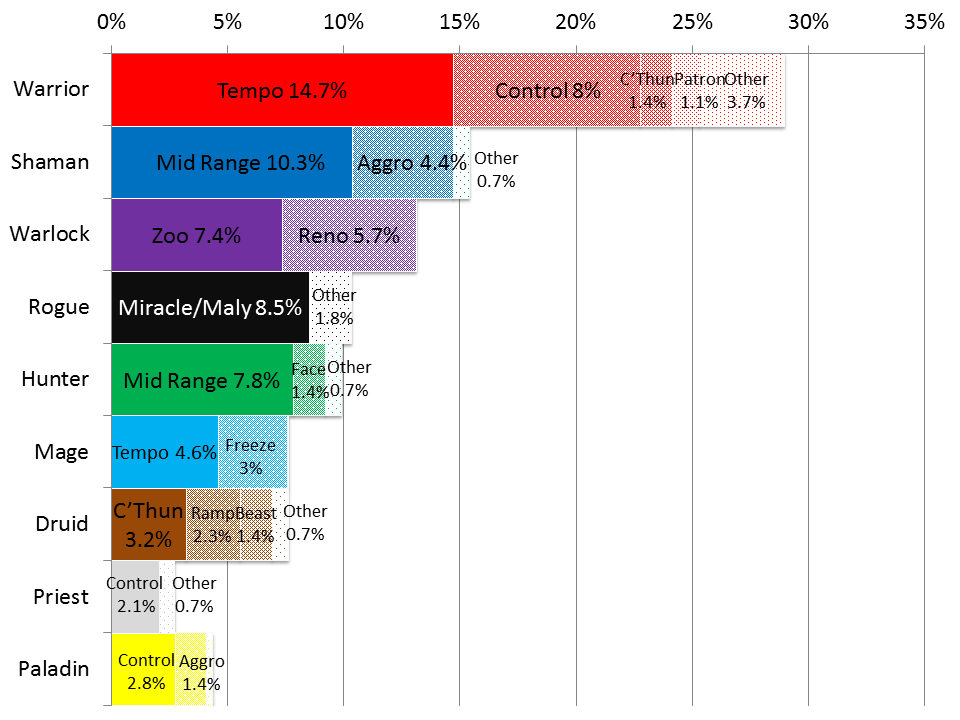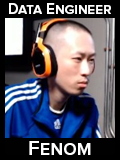Welcome to the very first vS Data Reaper Report!
What is the vS Data Reaper?
The vS Data Reaper is an ambitious project that we have been developing for several months. Over this period, we have recruited a large group of players in the vS community, most of whom are high-level players, and whose games we track via the Track-O-Bot program. We collect all in-game information and in a central database that we have developed internally. The database allows us to provide insights based on statistical analyses, some of which we have already published:
These articles are pretty simple, but our goal was much bigger than that.
You’re probably all aware of the several websites that provide ‘meta-analyses’ to the community. Many hard working people gather decks from all across the internet, put them up together in lists, discuss them and sometimes rank them by their power.
There are two drawbacks to this approach:
- The analysis is subjective, and sometimes high-level players can have completely different opinions on the strengths of certain decks and the nature of certain match ups. Thus, because opinions vary, there is confusion among ladder players about the merits of decks and whether they should or should not be used.
- Currently, no site relies on (at least to our knowledge) hard data based on actual games played on ladder. Thus, the average Hearthstone player will not have a reliable resource for what they will actually queue into on ladder. The strongest decks as perceived by high level players are not necessarily the most common decks on ladder, though these articles often end up defining the Meta and become a self-fulfilling prophecy.
However, existing articles are of great value to the community. Because only Blizzard is privy to a large enough database that can truly “see” the Meta as it is, the articles do provide players some form of guidance.
Our goal is to complement the information that exists in the Hearthstone community in order to guide players about what is “out there” and to provide general insights about the decks that we have encountered. We have built a large database that is statistically viable, consisting of thousands of games every week. We have also created an algorithm capable of identifying deck archetypes by examining cards that were played by the opponent. This gives us the tools to provide a clear statistical picture of the frequency of classes and archetypes in any particular time frame.
We intend to publish the vS Data Reaper report every week. The weekly article will:
- Map the Standard Meta game that our trackers encountered in the past week.
- Provide news/commentary on the developments in the Meta for every particular class in the past week. This analysis will be written by a team of high level players, who have expertise in particular classes.
- Identify a deck or two that we believe are capable of countering the decks that are most popular on ladder. We call them – Meta-Breakers.
Is that all we can do with the database? No. The possibilities are endless and this is where you come in. If we further grow our database, we will be able to provide detailed analysis to the levels that only Blizzard is capable of doing right now. Blizzard does not share the data. We will! Imagine an analysis of card performance, evaluating win rates of certain cards when they’re played, or accurate, ladder-based analysis of matchups between decks.
How can you help with making this a reality? At the bottom of the article there is a link to a Google doc form in which you can submit your Track-o-Bot ID and your API number. It can be completely anonymous, and we won’t share your personal information or game data with anyone. If you don’t use Track-o-bot, you can install it. It’s easy to use, barely takes any memory to run and all it needs to be doing is run in the background while you’re playing games.
Also, if you’re interested in contributing more in our efforts, feel free to contact us and we’ll be happy to connect with you. Any help or feedback is appreciated and will be addressed with our best efforts to create compelling analysis to the community.
So without further ado, let’s get into the numbers for the past week (data is from May 11th-17th)!
Overall Games Played
The chart depicts opponent’s class and archetypes based on frequency of occurrence. Classes are ordered from most common to least common.
Games Played in Legend Ranks
 These are the numbers only for games played at Legend rank. The database is relatively small here due to the time of the month, but it is still insightful.
These are the numbers only for games played at Legend rank. The database is relatively small here due to the time of the month, but it is still insightful.

With the introduction of “standard” the Warrior class has seen a well-deserved rise to fame. During EU preliminaries, Warrior was the most played class with the second highest win percentage amongst the whole field. The majority of Warrior decks at EU preliminaries were “Tempo Warrior”, the current flavor of the month. Following Tempo Warrior, we have Control Warrior, which has been an existing archetype since the inception of Hearthstone, and has truly withstood the test of time. Other Warrior decks that were played, but were not so popular, were Patron Warrior and the aggressive Pirate Warrior.
Tempo Warrior’s strategy is implied in its name – maintain tempo throughout the game. Get on board early and never lose control of the board. If you find yourself losing control of the board, there are very few ways to get it back outside of huge whirlwind swings. With this deck you want to consistently be applying pressure on your opponent’s life total while controlling the board.
Most Tempo Warrior lists have the same shell. Some lists choose to cut whirlwind and have evolved to become more aggressive with cards like Leeroy, going for the full aggressive strategy. Aside from those lists, the cards which are usually added or subtracted are Fierce Monkey, Arathi Weaponsmith, Archethief Rafaam, Varian Wrynn, Sylvanas Windrunner, and Cairne Bloodhoof.
The strategy of Control Warrior has been consistent throughout all of Hearthstone and has not changed with the introduction of standard. The name of the game is to control the board and amass an amount of armor that will make your opponent contemplate why they haven’t conceded the game yet. Of course Control Warrior got some new tools from WoToG such as Bloodhoof Brave and Ravaging Ghoul, but the defensive nature of these cards assists the strategy it is executing each game. Control Warrior is a deck where you can test out different counts of cards like Revenge, Acolyte, Brawl, etc., depending on the Meta but the skeleton should remain the same. Most of the legendaries aside from Justicar and Grommash are also interchangeable depending on the Meta.
Patron Warrior has been reduced to a shadow of its former self in the current Meta. The deck still saw success at Dreamhack, being piloted by TerrenceM. Since Terrence’s run at Dreamhack though, Patron has completely fallen off the map, especially at the EU preliminaries. Terrence’s variant of Patron is likely still the best out there but the deck is abysmal in a Meta filled with control decks boasting multiple AOE board clears.
Pirate Warrior did not do well in any major tournaments recently aside from the most recent ONOG, where Zalae piloted it to a victory and opened everyone’s eyes to the potential power of the archetype. There is a chance this deck will make a splash at the NA preliminaries as a nod to people ignoring aggressive decks, but that seems unlikely.
- Thijs’ Tempo Warrior at EU preliminaries
- Standard Control Warrior
- Terrence’s Patron Warrior at Dreamhack
- Zalae’s Pirate Warrior at ONOG

Aggro Shaman has grown to be one of the strongest archetypes the class has ever seen. With its ability to overwhelm and defeat your opponent at such a fast pace, it is certainly a strong contender in the current state of the Meta. Tunnel Trogg is MVP; With the overload synergy of other minions and spells such as Totem Golem, Flamewreathed faceless and Feral Spirits, it can create insane early game pressure and force your opponent to deal with these threats. Doomhammer equipped with Rockbiter Weapon and spell damage from Lava Burst or Lightning Bolt are usually used to end the game.
Aggro Shaman is one of the few decks lightly affected by the recent release of the WoToG expansion and standard format. This allows early refinement of the deck, giving it an edge over newer decks being created and keeping it top tier. Eternal Sentinel and Flamewreathed Faceless are the main additions to the deck creating a more board centric build.
Mid-Range Shaman is no stranger to the shaman class. The Old Gods expansion has revived and made the archetype viable once again amongst professionals in the scene and it is now the most common archetype seen on ladder. Not only did it acquire new tools to support it like Thing From Below and Master of Evolution, but the game has slowed down tremendously. This is where the deck thrives because it allows you to create board presence keeping your opponent under consistent minion pressure, complemented by the burst potential of Doomhammer or Bloodlust.
Loyan recently piloted a Bloodlust Totem shaman variant to top 8 in the European spring preliminaries as, utilizing one copy of Primal Fusion from the new set.

WoToG has done little to change the main archetypes for the Warlock class leaving it with the standard Zoo as well as Renolock. The nerf to Molten Giant as well as the loss of Antique Healbot has dealt a strong blow to the Handlock archetype, and it remains to be seen whether a successful variant of it can emerge. Some Zoo variants have gone back to their roots with both Doomguard and Soulfire gaining popularity. On top of this, many new tech cards have begun popping up in Zoo lists such as Mortal Coil and Crazed Alchemist to help improve certain matchups including Freeze Mage and the mirror match.
Renolock has two main variants at the moment, which are standard Renolock and N’Zoth Renolock. Both variants as well as zoo have proven themselves this past weekend by making very convincing appearances at the EU preliminaries.
- Crane’s N’Zoth Renolock at EU preliminaries
- Loyan’s Renolock at EU preliminaries
- Chakki’s Zoo at Dreamhack

After the nerf to Blade Flurry, almost every Rogue player thought the class would be near unplayable. Much to everyone’s surprise, Rogue became one of the strongest decks in the standard format because many of the other decks lost so much of their power. While there was heavy experimentation when standard format first came out with Shadowcaster and Unearthed Raptor, after the dust settled, two of the traditional Rogue decks stood on top: Malygos and Miracle Rogue.
Both decks have similar play styles, playing defensively during the first couple turns then making a high tempo play with cards like Van Cleef, Auctioneer, and Preparation. The difference is that Miracle Rogue can choose to be very aggressive with Cold Blood and Conceal, at the cost of having the potential to draw awkward hands due to running more situational cards. Malygos rogue is generally more consistent, but takes longer to finish out the game, usually needing to have a combination of an Emperor Thaurissan play setting up the Malygos finisher with burn spells.
One advantage of Rogue is the ability to add tech cards and still find success. In Malygos Rogue, Chessdude has recently run both Harrison Jones and Dark Iron Skulker to counter Warriors and Zoo respectively. Some players, including the America’s winter champion, Amnesiac, have added Southsea Deckhand and Faceless Manipulator as a combo finisher to Miracle Rogue, adding stronger burst damage against control decks like N’Zoth Paladin and Renolock. Shadow Strike has begun to appear in order to kill higher health minions like Darkshire Councilmen, while Xaril has started showing up in both variants of Rogue just as another value minion to shore up the control matchups.
While Rogue still struggles against full force aggressive decks such as Aggro Shaman and Pirate Warrior, it does extremely well against control decks and midrange decks with the exception of Freeze Mage, putting it in a strong place in the Meta. Several players that qualified for the European spring championship brought Miracle Rogues and Chessdude recently hit rank 1 with Malygos Rogue.

Hunter is in an interesting spot in the Meta. In the tournament scene, it has fallen off completely since the release of the new expansion. Hunter is no longer the best option for an aggressive strategy and the tools available to it do not appear to be good enough to make a viable and consistent control Hunter deck. With the loss of Mad Scientist and Haunted Creeper, Hunter has a harder time staying on the board early and can get overrun by aggressive decks very quickly. Yet on ladder, according to our data, it retains a middle of the road spot.
If you are looking to play Hunter on ladder at the moment, we recommend a Midrange Hunter built by Mr. Yagut which had some success in the early part of the Meta. The deck fills the void left by Mad Scientist and Haunted Creeper by utilizing Doomsayers to gain initiative on the board in the early game, in addition to setting up Call of the Wild on an empty board. The deck performs well against control decks, which might explain a recent surge in the archetype’s popularity. With some adjustments, it may turn out to be a great deck to use on ladder.
At the EU Spring Preliminaries, three out of the eight advancing players brought Freeze Mage. Freeze Mage is a very strong deck in the Meta right now but has very polarizing matchups. It will always be stronger in tournaments than on ladder because of the popularity of the Warrior class. While Tempo Mage has been relatively popular on ladder, it hasn’t seen much play in tournaments. The loss of Mad Scientist and the Shaman class rising to power are two of the biggest causes to Tempo Mage’s slide.
For the most part, the biggest change in Freeze Mage lists after the introduction of standard was the addition of two copies of Loot Hoarders and Novice Engineers to replace Mad Scientists. However, this list is far from optimal because without Mad Scientists, two copies of Ice Barriers are much too slow. Even in the matchups in which Ice Barrier is good, you want to be proactive, and not spend mana without drawing cards or freezing the board. Rogue is an important matchup so one copy of Ice Barrier is often included for that reason.
Mirror Image is a viable tech choice that is often overlooked, and saw play before the Naxx expansion. It can fill the curve better as it only costs 1 mana, protects doomsayer from minions or Stampeding Kodo (a card that has seen a large increase in popularity), and prevents at least 4 damage, but often upwards of 8, if you’re facing a minion such as Flamewreathed Faceless. It also makes dumping your hand easier when you need to draw more cards to find a one turn kill versus control decks.
Pyroblast has seen a decrease in play recently because there is no longer a need for much more than the key 15 damage after an Alexstrasza turn since the removal of Antique Healbot from the game. Cone of Cold can also be swapped for Flamestrike if you want to tech versus heavier decks. There has also been some talk about removing Alexstrasza for a strategy completely surrounded around OTK with additional draw and spell-power.

Despite the basic concept of using “ramp” cards such as Wild Growth and Innervate (and the addition of Mire Keeper) sticking around, the infamous Force of Nature/Savage Roar combo has been removed from the game. This change, along with new cards being released, has shifted the Druid class into other strategies. Two main archetypes that have been performing well at recent tournaments are C’Thun Druid and Beast Druid.
C’Thun Druid is heavily minion based, which makes it strong in the late game as it very rarely loses due to a lack of resources. This deck, utilized by AKAWonder in the EU preliminaries to reach the top 8, is meant to target some of the control decks that had seen success at EGLX and Dreamhack such as Control Warrior, N’Zoth Paladin, and N’Zoth Priest. It functions similarly to the classic Ramp Druid deck, which utilizes hefty minions such as Ancient of War and Cenarius, with the key difference being the option of having the powerful finisher that is C’Thun.
Moreover, unlike the more passive Ramp Druid, C’Thun cards offer an early game curve with minions such as Beckoner of Evil and Disciple of C’Thun, which are particularly good against the popular aggressive decks on ladder such as Zoo and Aggro Shaman.
In a completely different fashion, Beast Druid attempts to end the game somewhere in the middle, before combo decks such as Miracle Rogue can start to truly function, and before the control decks can stabilize and take over the game. Despite this deck being aggressive in nature, it doesn’t utilize a lot of low cost minions, which makes it somewhat reliant on Innervate. However, the efficiency of cards like Savage Combatant, Druid of the Claw, and Violet Teacher, provides the deck with multiple threats during the mid-game. Beast Druid can set up big turns of damage due to the synergy between Savage Roar and Violet Teacher, and having just a couple of minions on the board can still allow Savage Roar to carry you the distance.

Are we supposed to be surprised that Priest is at an odd crossroads as the Meta starts to settle? Priest has and always been different from the rest of the classes due to its reactive nature. This is the exact reason why we have always seen the Control Priest at the top of the Priest food chain. Dragons have tried to chomp their way up there at times, but the Priest class more than any other is shaped by the current Meta.
Control Priest reigned supreme at Dreamhack, where the GNC build used by Chakki performed quite admirably. The extensive testing done by the group led to the discovery that this fairly greedy control list fit perfectly into this out of “control” Meta.
Just enough tools and tech such as Doomsayer and Excavated Evil was left around to compensate for no Cabal Shadow Priest and the inclusion of cards like Harrison Jones and Elise Starseeker. The list has very few actual deathrattles to pair with N’Zoth the Corruptor. The reason behind this is that N’Zoth is not the stand alone win condition; he acts a stepping stone with potential to close out games.
Another interesting Priest deck that has found recent success is Firebat’s “Freeze” OTK Priest that was utilized in Starladder. The deck is based on stalling the game with Priest’s great early removal and draw options, playing Emperor and setting up a single turn in order to burst down your opponent, very similar to Freeze Mage. This deck fits right into the theme of punishing control decks with inevitably of threatening damage.
Priest can be built to beat any one single deck with all of the tools at its disposal; it’s the ability to make the correct Meta reads that separate the Zetalots from the rest, which makes the class more difficult to successfully pilot than others.

Paladin has lost all of its strong early game since standard format hit, and this has pushed the class in a very different, slower direction. N’Zoth Paladin has been the king of Paladin decks since WoToG was released, and after Chakki’s first place finish at Dreamhack, many players have been using his list with all its unusual tech choices. It runs Eadric, which can singlehandedly save games against Rogue or board control decks, and Ragnaros the Firelord, which can snipe Auctioneers or pressure Freeze Mages, as well as Justicar Trueheart to win the control mirrors.
Another prominent success of the deck was AKAWonder’s victory at the EU Spring Preliminaries; his list focused on additional Deathrattles, like Corrupted Healbot and Twilight Summoner, as well as Keeper of Uldaman for added flexibility.
Aggro Paladin has adherents too, and several players are brewing their own lists; LBYS took top 4 in the latest ONOG qualifier with a build featuring Steward of Darkshire and Rallying Blade. However, no list to date has been consistent enough to displace N’Zoth as the most common archetype within the class.
- Chakki’s N’Zoth Paladin at Dreamhack Austin
- AKA Wonder’s N’Zoth Paladin at EU preliminaries
- LBYS’ Aggro Paladin at ONOG

 Taking a closer look at the Meta, we can firmly establish that Warrior, Shaman and Warlock are the most dominant classes on ladder. In addition to that, Aggro Shaman is the only aggressive deck that has a significant presence in the current Meta. We have been noticing that Pirate Warriors are beginning to see more play, and may make an appearance in our Meta chart next week, but that remains to be seen.
Taking a closer look at the Meta, we can firmly establish that Warrior, Shaman and Warlock are the most dominant classes on ladder. In addition to that, Aggro Shaman is the only aggressive deck that has a significant presence in the current Meta. We have been noticing that Pirate Warriors are beginning to see more play, and may make an appearance in our Meta chart next week, but that remains to be seen.
We believe that Miracle Rogue might be underrated by ladder players based on its matchups against these classes. With the loss of Death’s Bite and the re-emergence of Gadgetzan Auctioneer, Rogue does relatively well against all Warrior archetypes (besides Pirate Warrior). It also fares well against Mid-Range Shamans, and dominates both Zoo and Reno Warlocks. Its natural counters are currently scarce, so Rogue could be facing an upward trend. Indeed, if you’re facing the Metagame exhibited by these charts, picking up and learning to master Miracle Rogue might help you on your quest to reach the top ranks. Happy hunting, Valeera!
If you’d like updates on our future articles, follow us on Twitter! @ViciousHS
Here are all the people that participated in bringing you this edition of the vS Data Reaper Report:
















